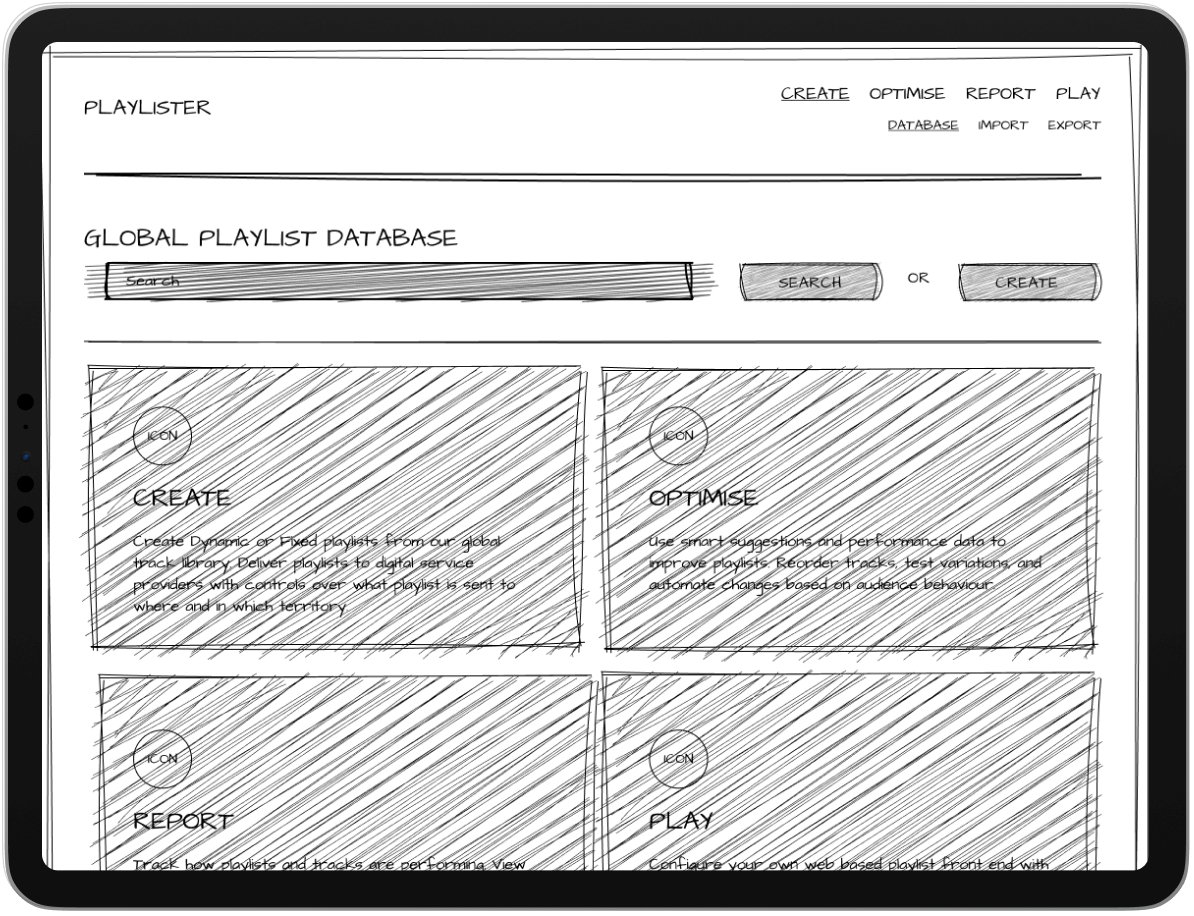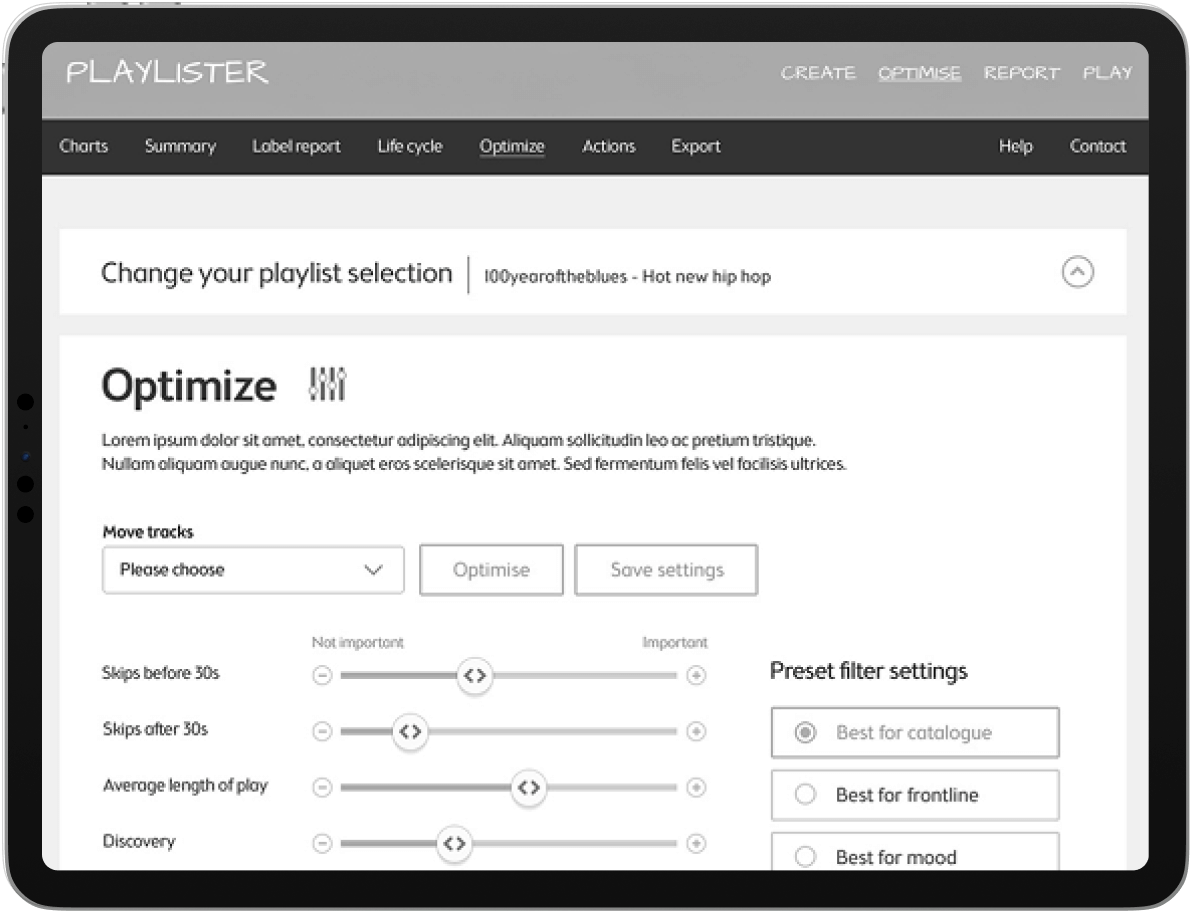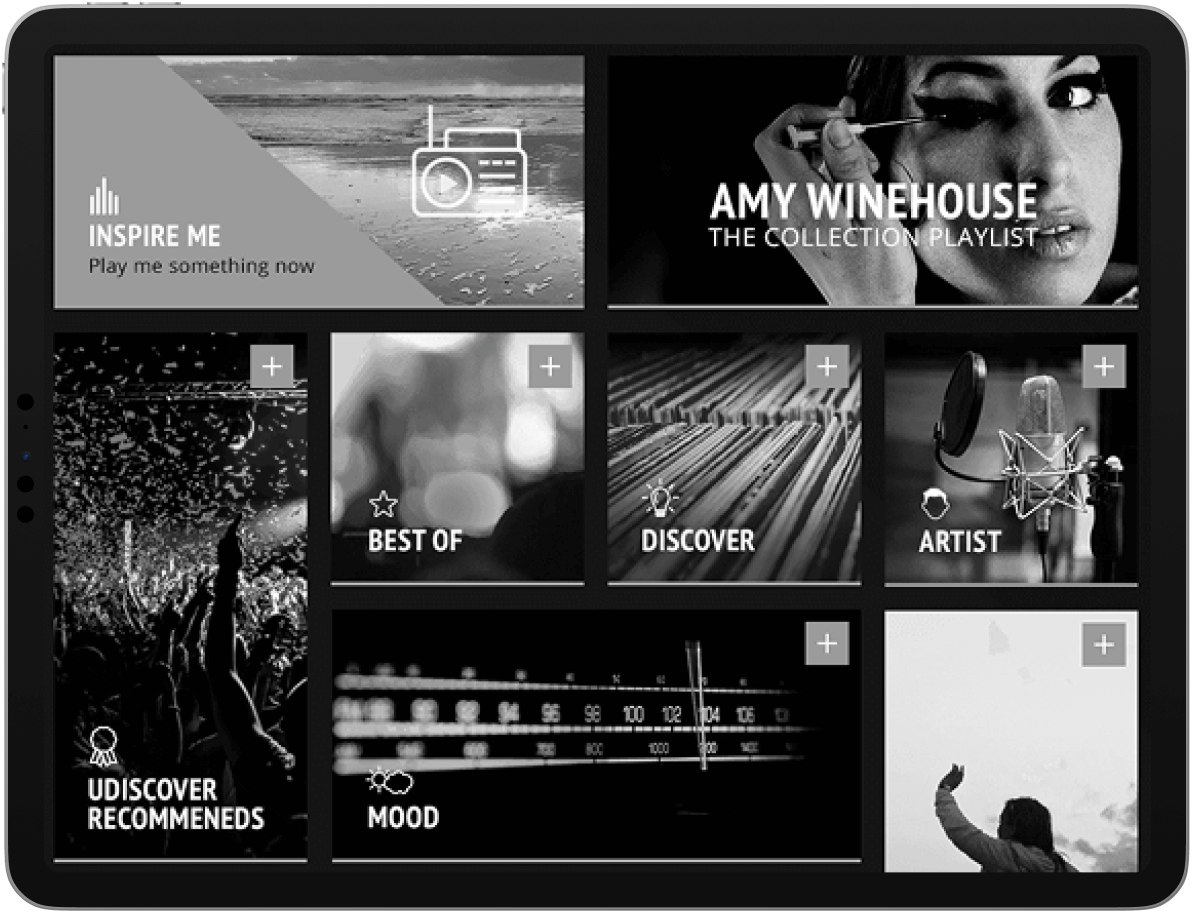Case Study
Playlister
Product innovation
Product strategy
Product design
User Interface/Experience Platform architecture
An internal tool that started as a quick fix for playlist curation ended up transforming how a major record label managed, optimised and scaled its catalogue across global streaming platforms. We led the strategy, design and build of a platform that supported everything from day-to-day curation to the release of fixed playlists as streaming-only products; delivering new revenue, creative control, and operational efficiency.
The Challenge
Curation was slow, fragmented and focused only on Spotify. The label needed a shared platform to manage playlists, unlock data and replace a major revenue stream.
Our Solution
We built a scalable platform for playlist creation, automation and syndication. It replaced manual work and enabled both dynamic and fixed playlists across services.
The Impact
The platform powered over 200 releases a week, boosted engagement by up to 77 percent and delivered more than $100 million euros in new streaming revenue.
Strategic Process
A modular approach from insight to implementation
Phase 1
Discovery
Uncovering the real barriers to playlisting at scale
Before anything could be designed or built, we needed to understand the full scope of the problem. We spoke to teams across markets, labels and central functions to map existing workflows, tools, bottlenecks and business risks. What emerged was a clear picture of the fragmentation, duplication and opportunity buried inside the label’s global playlisting operations.
Uncovering the real barriers to playlisting at scale
-
Curation was handled independently across teams, with no shared visibility
-
Legacy workflows relied on manual processes and unstructured metadata
-
Existing tools were built around Spotify only, limiting multi platform support
-
Data was underused, with decisions driven by habit rather than insight
Results

50+
Hours - of interviews with curators, editors and central teams

1000’s
Of playlists - created but often unmanaged or duplicated

30+
Teams - creating playlists across the globe in silos
People & Process
No shared system for playlist tracking
Curation decisions vary market to market
Email and spreadsheets are still the norm
Local teams duplicate playlists unknowingly
No standard onboarding for new curators
Editorial vs commercial goals often misaligned
Some playlists live on personal accounts
Central teams lack visibility on local output
No one owns end to end workflow
Tools & Technology
Legacy tools built around Spotify only
No way to syndicate playlists beyond manual uploads
Data lives in disconnected spreadsheets
No search function for existing playlists
Tags not used consistently (if at all)
Track suggestion tools do not exist
No API for artist or label sites
No audit trail for changes or ownership
Reordering tracks = manual process
Content & Catalogue
Huge gaps in catalogue coverage across services
Fixed playlists live outside any system
Repertoire experts working in isolatio
Hundreds of playlists with no engagement
Regional genres not represented consistently
Metadata inconsistencies block syndication
Local naming conventions limit discovery
Mood and theme tags underused
No feedback loop from DSPs
Opportunity & Risk
Fixed playlist revenue tied to third party
Editorial teams unable to scale output
Duplication hurts audience growth
No visibility into what is working
Missed opportunities beyond Spotify
Slower time to market vs competitors
Playlists not optimised for SEO
Search indexing opportunity not captured
Risk of losing key revenue stream if FP partnership ends
Phase 2
Definition
Turning fragmented workflows into a unified product vision
With the pain points clear, we moved into shaping what the solution needed to be. This phase focused on aligning business needs with user requirements, translating messy day to day realities into a coherent product strategy. We mapped out core use cases, defined feature sets, and created a modular system blueprint that could flex for local needs while scaling globally.
Key Features required
-
A shared global playlist database with roles and permissions
-
Fixed and dynamic playlist creation as distinct modes
-
Syndication to multiple DSPs from a single interface
-
Optimisation layer with predictive track ordering and performance data
-
CMS and API framework to power apps, smart links and consumer playback
Results

5
Key modules - defined to support end-to-end playlisting

30+
User stories - developed from interviews and workflows

1
Shared vision - agreed across product, editorial and commercial teams
Requirement
Functionality
BRAND TITLE:
Can edit
PLAYLIST NAME
Can edit
PLAYLIST DESCRIPTION
100 character optimal
ADD ART
Approved artwork
PRIMARY OWNER
Selection by approved staff
SECONDARY OWNER
Selection by approved staff
SELECT STREAMING SERVICE
Multi selection
FND TRACKS
Search / Filter genre / select lobel
ADD TAGGING
Display Genre / Mood / Artist / There
PLAYLIST CREATION
Display: Morket / Track voure / Playlist length / Track nome &e ortist
Phase 3
Design
Designing for scale, speed and simplicity
With the product definition locked, we moved into UX and UI design. The challenge was to create an interface flexible enough for global teams, but focused enough to support fast, everyday use. We worked in close collaboration with curators, product leads and developers to prototype core journeys, streamline common tasks and bring complex capabilities into a simple, modular interface.
Key Features required
-
Modular layout built around the five core functions
-
Clean UI that works across workflows
-
Smart defaults to reduce decision fatigue and speed up curation
-
User roles, tagging and audit trails built into the design layer
Results

40+
Wireframes - prototyped across platform modules and user journeys

12
Test sessions - held with teams in key global markets

1
Design system - created to support future features and frontend sms
Lo-fi wireframing
VALIDATION

Phase 4
Validation
Testing the system with real teams and real data
With designs in place, we moved into hands on validation. This phase focused on pressure testing the system with real users, real playlists and real constraints. We ran playtests across teams, tracked behaviours, and used early integrations to simulate workflows. What we learned shaped everything from feature prioritisation to onboarding, automation defaults and performance tracking.
Key Features required
-
Interactive prototypes tested with live playlists and user data
-
Early integrations used to trial playlist creation and syndication
-
Feedback loops built into tagging, automation and optimisation tools
-
Onboarding and training refined based on observed user behaviour
Results

90%
Of Deezer - classical browse slots populated after syndication

8
Pilot teams - onboarded across editorial, curation and catalogue

800+
Playlists - syndicated during the test phase
Hi-fi prototype
VALIDATION

Phase 5
Implimentation
Rolling out the system and scaling global adoption
With the platform built and validated, we moved into implementation. This phase focused on rolling out Playlister across markets, onboarding teams, and scaling up fixed playlist creation. We set up tooling, training and support to help local editors adopt new workflows and replace legacy systems. The result was a fast, coordinated shift from siloed curation to a connected global operation.
Key Features
-
Fixed playlist builder launched to support streaming only compilations
-
Tagging and taxonomy standards embedded to support SEO and analytics
-
MS and API rollout powering own playlist brand websites with partner integrations
-
Optimisation layer with predictive track ordering and performance data
-
Central operations support and training materials built for scale
Results

200+
Fixed playlists -
released weekly at peak adoption

77%
Uplift - in engagement on optimised playlists

$100m+
Incremental - streaming revenue delivered
< / >
IMPLIMENTATION

Transformative Results
Measurable impact across all key performance indicators
1
Global system
adopted across dozens of teams and markets
5
Core modules
powering the full playlist supply chain
200+
Playlists
released each week
77%
Uplift
in playlist engagement through optimisation tools
>$100m
Incremental
streaming revenue generated
Case Studies
Connect with us to explore your project's potential.
Address
71-75 Shelton Street
Covent Garden
London
WC2H 9JQ
Contact
info@wearediverge.com
Social
Spotify
Product. Design. Brand. Technology.
© 2025 Diverge Ltd, Registered in England
No. 15396926, VAT No. 462 1505 18
Case Study
Playlister
Product innovation
Product strategy
Product design
User Interface/Experience Platform architecture
An internal tool that started as a quick fix for playlist curation ended up transforming how a major record label managed, optimised and scaled its catalogue across global streaming platforms. We led the strategy, design and build of a platform that supported everything from day-to-day curation to the release of fixed playlists as streaming-only products; delivering new revenue, creative control, and operational efficiency.
The Challenge
Curation was slow, fragmented and focused only on Spotify. The label needed a shared platform to manage playlists, unlock data and replace a major revenue stream.
Our Solution
We built a scalable platform for playlist creation, automation and syndication. It replaced manual work and enabled both dynamic and fixed playlists across services.
The Impact
The platform powered over 200 releases a week, boosted engagement by up to 77 percent and delivered more than $100 million euros in new streaming revenue.
Strategic Process
A modular approach from insight to implementation
Phase 1
Discovery
Uncovering the real barriers to playlisting at scale
Before anything could be designed or built, we needed to understand the full scope of the problem. We spoke to teams across markets, labels and central functions to map existing workflows, tools, bottlenecks and business risks. What emerged was a clear picture of the fragmentation, duplication and opportunity buried inside the label’s global playlisting operations.
Uncovering the real barriers to playlisting at scale
-
Curation was handled independently across teams, with no shared visibility
-
Legacy workflows relied on manual processes and unstructured metadata
-
Existing tools were built around Spotify only, limiting multi platform support
-
Data was underused, with decisions driven by habit rather than insight
Results

50+
Hours - of interviews with curators, editors and central teams

1000’s
Of playlists - created but often unmanaged or duplicated

30+
Teams - creating playlists across the globe in silos
People & Process
No shared system for playlist tracking
Curation decisions vary market to market
Email and spreadsheets are still the norm
Local teams duplicate playlists unknowingly
No standard onboarding for new curators
Editorial vs commercial goals often misaligned
Some playlists live on personal accounts
Central teams lack visibility on local output
No one owns end to end workflow
Tools & Technology
Legacy tools built around Spotify only
No way to syndicate playlists beyond manual uploads
Data lives in disconnected spreadsheets
No search function for existing playlists
Tags not used consistently (if at all)
Track suggestion tools do not exist
No API for artist or label sites
No audit trail for changes or ownership
Reordering tracks = manual process
Content & Catalogue
Huge gaps in catalogue coverage across services
Fixed playlists live outside any system
Repertoire experts working in isolatio
Hundreds of playlists with no engagement
Regional genres not represented consistently
Metadata inconsistencies block syndication
Local naming conventions limit discovery
Mood and theme tags underused
No feedback loop from DSPs
Opportunity & Risk
Fixed playlist revenue tied to third party
Editorial teams unable to scale output
Duplication hurts audience growth
No visibility into what is working
Missed opportunities beyond Spotify
Slower time to market vs competitors
Playlists not optimised for SEO
Search indexing opportunity not captured
Risk of losing key revenue stream if FP partnership ends
Phase 2
Definition
Turning fragmented workflows into a unified product vision
With the pain points clear, we moved into shaping what the solution needed to be. This phase focused on aligning business needs with user requirements, translating messy day to day realities into a coherent product strategy. We mapped out core use cases, defined feature sets, and created a modular system blueprint that could flex for local needs while scaling globally.
Key Features required
-
A shared global playlist database with roles and permissions
-
Fixed and dynamic playlist creation as distinct modes
-
Syndication to multiple DSPs from a single interface
-
Optimisation layer with predictive track ordering and performance data
-
CMS and API framework to power apps, smart links and consumer playback
Results

5
Key modules - defined to support end-to-end playlisting

30+
User stories - developed from interviews and workflows

1
Shared vision - agreed across product, editorial and commercial teams
Requirement
Functionality
BRAND TITLE:
Can edit
PLAYLIST NAME
Can edit
PLAYLIST DESCRIPTION
100 character optimal
ADD ART
Approved artwork
PRIMARY OWNER
Selection by approved staff
SECONDARY OWNER
Selection by approved staff
SELECT STREAMING SERVICE
Multi selection
FND TRACKS
Search / Filter genre / select lobel
ADD TAGGING
Display Genre / Mood / Artist / There
PLAYLIST CREATION
Display: Market / Track volume / Playlist length / Track name & artist
Phase 3
Design
Designing for scale, speed and simplicity
With the product definition locked, we moved into UX and UI design. The challenge was to create an interface flexible enough for global teams, but focused enough to support fast, everyday use. We worked in close collaboration with curators, product leads and developers to prototype core journeys, streamline common tasks and bring complex capabilities into a simple, modular interface.
Key Features required
-
Modular layout built around the five core functions
-
Clean UI that works across workflows
-
Smart defaults to reduce decision fatigue and speed up curation
-
User roles, tagging and audit trails built into the design layer
Results

40+
Wireframes - prototyped across platform modules and user journeys

12
Test sessions - held with teams in key global markets

1
Design system - created to support future features and frontend sms
Lo-fi wireframing
VALIDATION

Phase 4
Validation
Testing the system with real teams and real data
With designs in place, we moved into hands on validation. This phase focused on pressure testing the system with real users, real playlists and real constraints. We ran playtests across teams, tracked behaviours, and used early integrations to simulate workflows. What we learned shaped everything from feature prioritisation to onboarding, automation defaults and performance tracking.
Key Features required
-
Interactive prototypes tested with live playlists and user data
-
Early integrations used to trial playlist creation and syndication
-
Feedback loops built into tagging, automation and optimisation tools
-
Onboarding and training refined based on observed user behaviour
Results

90%
Of Deezer - classical browse slots populated after syndication

8
Pilot teams - onboarded across editorial, curation and catalogue

800+
Playlists - syndicated during the test phase
Hi-fi prototype
VALIDATION

Phase 5
Implimentation
Rolling out the system and scaling global adoption
With the platform built and validated, we moved into implementation. This phase focused on rolling out Playlister across markets, onboarding teams, and scaling up fixed playlist creation. We set up tooling, training and support to help local editors adopt new workflows and replace legacy systems. The result was a fast, coordinated shift from siloed curation to a connected global operation.
Key Features
-
Fixed playlist builder launched to support streaming only compilations
-
Tagging and taxonomy standards embedded to support SEO and analytics
-
MS and API rollout powering own playlist brand websites with partner integrations
-
Optimisation layer with predictive track ordering and performance data
-
Central operations support and training materials built for scale
Results

200+
Fixed playlists -
released weekly at peak adoption

77%
Uplift - in engagement on optimised playlists

$100m+
Incremental - streaming revenue delivered
< / >
IMPLIMENTATION

Transformative Results
Measurable impact across all key performance indicators
1
Global system
adopted across dozens of teams and markets
5
Core modules
powering the full playlist supply chain
200+
Playlists
released each week
77%
Uplift
in playlist engagement through optimisation tools
>$100m
Incremental
streaming revenue generated
Case Studies
Connect with us to explore your project's potential.
Address
71-75 Shelton Street
Covent Garden
London
WC2H 9JQ
Contact
020 8226 0474
info@wearediverge.com
Social
Spotify
Product. Design. Branding. Technology.
© 2025 Diverge Ltd, Registered in England No. 15396926, VAT No. 462 1505 18
Case Study
Playlister
Product innovation
Product strategy
Product design
User Interface/Experience Platform architecture
An internal tool that started as a quick fix for playlist curation ended up transforming how a major record label managed, optimised and scaled its catalogue across global streaming platforms. We led the strategy, design and build of a platform that supported everything from day-to-day curation to the release of fixed playlists as streaming-only products; delivering new revenue, creative control, and operational efficiency.
The Challenge
Curation was slow, fragmented and focused only on Spotify. The label needed a shared platform to manage playlists, unlock data and replace a major revenue stream.
Our Solution
We built a scalable platform for playlist creation, automation and syndication. It replaced manual work and enabled both dynamic and fixed playlists across services.
The Impact
The platform powered over 200 releases a week, boosted engagement by up to 77 percent and delivered more than $100 million euros in new streaming revenue.
Strategic Process
A modular approach from insight to implementation
Phase 1
Discovery
Uncovering the real barriers to playlisting at scale
Before anything could be designed or built, we needed to understand the full scope of the problem. We spoke to teams across markets, labels and central functions to map existing workflows, tools, bottlenecks and business risks. What emerged was a clear picture of the fragmentation, duplication and opportunity buried inside the label’s global playlisting operations.
Uncovering the real barriers to playlisting at scale
-
Curation was handled independently across teams, with no shared visibility
-
Legacy workflows relied on manual processes and unstructured metadata
-
Existing tools were built around Spotify only, limiting multi platform support
-
Data was underused, with decisions driven by habit rather than insight
Results

50+
Hours - of interviews with curators, editors and central teams

1000’s
Of playlists - created but often unmanaged or duplicated

30+
Teams - creating playlists across the globe in silos
Content & Catalogue
Huge gaps in catalogue coverage across services
Fixed playlists live outside any system
Repertoire experts working in isolatio
Hundreds of playlists with no engagement
Regional genres not represented consistently
Metadata inconsistencies block syndication
Local naming conventions limit discovery
Mood and theme tags underused
No feedback loop from DSPs
Opportunity & Risk
Fixed playlist revenue tied to third party
Editorial teams unable to scale output
Duplication hurts audience growth
No visibility into what is working
Missed opportunities beyond Spotify
Slower time to market vs competitors
Playlists not optimised for SEO
Search indexing opportunity not captured
Risk of losing key revenue stream if FP partnership ends
People & Process
No shared system for playlist tracking
Curation decisions vary market to market
Email and spreadsheets are still the norm
Local teams duplicate playlists unknowingly
No standard onboarding for new curators
Editorial vs commercial goals often misaligned
Some playlists live on personal accounts
Central teams lack visibility on local output
No one owns end to end workflow
Tools & Technology
Legacy tools built around Spotify only
No way to syndicate playlists beyond manual uploads
Data lives in disconnected spreadsheets
No search function for existing playlists
Tags not used consistently (if at all)
Track suggestion tools do not exist
No API for artist or label sites
No audit trail for changes or ownership
Reordering tracks = manual process
Phase 2
Definition
Turning fragmented workflows into a unified product vision
With the pain points clear, we moved into shaping what the solution needed to be. This phase focused on aligning business needs with user requirements, translating messy day to day realities into a coherent product strategy. We mapped out core use cases, defined feature sets, and created a modular system blueprint that could flex for local needs while scaling globally.
Key Features required
-
A shared global playlist database with roles and permissions
-
Fixed and dynamic playlist creation as distinct modes
-
Syndication to multiple DSPs from a single interface
-
Optimisation layer with predictive track ordering and performance data
-
CMS and API framework to power apps, smart links and consumer playback
Results

5
Key modules - defined to support end-to-end playlisting

30+
User stories - developed from interviews and workflows

1
Shared vision - agreed across product, editorial and commercial teams
Requirement
Functionality
BRAND TITLE:
Can edit
PLAYLIST NAME
Can edit
PLAYLIST DESCRIPTION
100 character optimal
ADD ART
Approved artwork
PRIMARY OWNER
Selection by approved staff
SECONDARY OWNER
Selection by approved staff
SELECT STREAMING SERVICE
Multi selection
ADD TAGGING
Display Genre / Mood / Artist / There
FND TRACKS
Search / Filter genre / select lobel
PLAYLIST CREATION
Display: Market / Track volume / Playlist length / Track name & artist
Phase 3
Design
Designing for scale, speed and simplicity
With the product definition locked, we moved into UX and UI design. The challenge was to create an interface flexible enough for global teams, but focused enough to support fast, everyday use. We worked in close collaboration with curators, product leads and developers to prototype core journeys, streamline common tasks and bring complex capabilities into a simple, modular interface.
Key Features required
-
Modular layout built around the five core functions
-
Clean UI that works across workflows
-
Smart defaults to reduce decision fatigue and speed up curation
-
User roles, tagging and audit trails built into the design layer
Results

40+
Wireframes - prototyped across platform modules and user journeys

12
Test sessions - held with teams in key global markets

1
Design system - created to support future features and frontend sms
Lo-fi wireframing
VALIDATION

Phase 4
Validation
Testing the system with real teams and real data
With designs in place, we moved into hands on validation. This phase focused on pressure testing the system with real users, real playlists and real constraints. We ran playtests across teams, tracked behaviours, and used early integrations to simulate workflows. What we learned shaped everything from feature prioritisation to onboarding, automation defaults and performance tracking.
Key Features required
-
Interactive prototypes tested with live playlists and user data
-
Early integrations used to trial playlist creation and syndication
-
Feedback loops built into tagging, automation and optimisation tools
-
Onboarding and training refined based on observed user behaviour
Results

90%
Of Deezer - classical browse slots populated after syndication

8
Pilot teams - onboarded across editorial, curation and catalogue

800+
Playlists - syndicated during the test phase
Hi-fi prototype
VALIDATION

Phase 5
Implimentation
Rolling out the system and scaling global adoption
With the platform built and validated, we moved into implementation. This phase focused on rolling out Playlister across markets, onboarding teams, and scaling up fixed playlist creation. We set up tooling, training and support to help local editors adopt new workflows and replace legacy systems. The result was a fast, coordinated shift from siloed curation to a connected global operation.
Key Features
-
Fixed playlist builder launched to support streaming only compilations
-
Tagging and taxonomy standards embedded to support SEO and analytics
-
MS and API rollout powering own playlist brand websites with partner integrations
-
Optimisation layer with predictive track ordering and performance data
-
Central operations support and training materials built for scale
Results

200+
Fixed playlists -
released weekly at peak adoption

77%
Uplift - in engagement on optimised playlists

$100m+
Incremental - streaming revenue delivered
< / >
IMPLIMENTATION

Transformative Results
Measurable impact across all key performance indicators
1
Global system
adopted across dozens of teams and markets
5
Core modules
powering the full playlist supply chain
200+
Playlists
released each week
77%
Uplift
in playlist engagement through optimisation tools
>$100m
Incremental
streaming revenue generated
Case Studies
Connect with us to explore your project's potential.
Address
71-75 Shelton Street
Covent Garden
London
WC2H 9JQ
Contact
020 8226 0474
info@wearediverge.com
Social
Spotify
Product. Design. Branding. Technology.
© 2025 Diverge Ltd, Registered in England No. 15396926, VAT No. 462 1505 18
